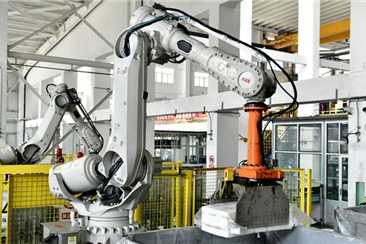Good times, uncertain times: a time to prepare

Our Regional Economic Outlook suggests a strong global and regional growth momentum. But there are also clouds on the horizon for which all need to prepare and now is the time to do it. China's reforms have stabilized the economy and progress has been made in financial deleveraging. Key will be to stay the course.
As we note in our recently released Regional Economic Outlook, the Asia-Pacific region remains the main engine of the global economy, and near-term prospects have improved since our report of October 2017. But there are many risks on the horizon, including a tightening of global financial conditions, a shift toward protectionist policies, and an increase in geopolitical tensions. In addition, over the longer run, Asian economies will face major challenges from population aging and slowing productivity growth, as well as the rise of the digital economy, which could yield huge benefits but also bring major disruptions.
Given these many uncertainties, macroeconomic policies in the region should be conservative and aimed at building buffers and increasing resilience, while taking advantage of strong economic conditions to implement structural reforms to promote sustainable and inclusive growth.
Regional growth is expected to remain strong at 5.6 percent in 2018 and 2019 -- up about 0.1 percentage points from our previous forecast -- supported by strong global demand and favorable financial conditions. As in other regions, inflation in Asia has largely remained subdued despite the pickup in growth. We project that inflation will remain at 1.4 percent on average in advanced economies and 3.3 percent on average in emerging markets. Among the larger economies, growth in Japan has been above potential for eight consecutive quarters and is expected to remain strong this year at 1.2 percent. And in India, after temporary disruptions caused by the currency exchange initiative and the rollout of the new Goods and Services Tax, growth is expected to recover to 7.4 percent, making it once again the region's fastest growing economy.
For China, 2018 is projected to ease to 6.6 percent from 6.9 percent in 2017, as financial, housing, and fiscal tightening measures take effect and net exports contribute less. Such a slowdown is necessary and will benefit China in the long run, as it reflects the economy's transition from a focus on quantity to quality of growth. CPI Inflation is expected to rise from 1.6 percent in 2017 to 2.5 percent in 2018, but remain moderate and in line with the regional trend.
Risks to near-term growth are balanced, but downside risks prevail over the medium term. On the upside, the global recovery could again prove stronger than expected. The new Comprehensive and Progressive Agreement for Trans-Pacific Partnership (CPTPP) and the successful implementation of China's Belt and Road Initiative—assuming debt sustainability and project quality are maintained -- could support trade, investment, and growth. Asia, however, remains vulnerable to a sudden and sharp tightening in global financial conditions, while extended periods of easy financial conditions could risk a buildup of leverage and financial vulnerabilities. More inward-looking policies in major global economies, as highlighted by recent tariff actions and announcements, could disrupt international trade and financial markets and have a substantial impact on Asia, which has benefited so much from economic integration. Finally, geopolitical tensions could have serious financial and economic repercussions.
Over the longer run, growth prospects for Asia will be heavily affected by demographics, slowing productivity growth, and the rise of the digital economy. Population aging is an important challenge, as many economies face the risk of "growing old before they grow rich," and the adverse effect of aging on growth and fiscal positions could be substantial. A second challenge is slowing productivity growth. Finally, the global economy is becoming increasingly digitalized, and while some recent advances could be truly transformative, they also bring challenges, including those related to the future of work. Asia in aggregate is embracing the digital revolution, but the degree varies significantly across the region.
The current strong economic outlook provides a valuable opportunity to focus macroeconomic policies on building buffers, increasing resilience, and ensuring sustainability. In many countries in the region, continued fiscal support is less urgent given strong economic performance, and policymakers should focus on ensuring that debt remains under control. Some countries should also focus on revenue mobilization to create space for infrastructure and social spending and to support structural reforms.
As for monetary policy, the policy stance can remain accommodative in much of the region given that inflation is generally still muted. Nonetheless, central banks should be vigilant, since our analysis suggests that much of the undershooting of inflation targets in Asia has been explained by temporary, global factors, such as commodity prices and imported inflation, which could reverse.
Finally, tailored measures are needed to boost productivity and investment, narrow gender gaps in labor force participation, deal with the demographic transition, address climate change, and support those affected by shifts in technology and trade. And to reap the full benefits of the digital revolution, Asia will need a comprehensive and integrated policy strategy covering information and communications technology, infrastructure, trade, labor markets, and education.
In China, reforms in the past two years have contributed to a reduction of near-term risks and stabilized the economy. In particular, progress has been made in financial deleveraging, which should continue. Recently issued regulation on asset management products and new liquidity rules are welcome and should help further unwind risks accumulated in the financial sector; key however, will be steadfast implementation. It will be important to further slow credit growth and improve credit allocation efficiency, which should go hand-in-hand with state-owned enterprise reforms and more forceful exit of zombie firms. Fiscal policy that fosters consumption, while curtailing excessive investment especially at the local level, would facilitate rebalancing and contribute to higher quality of growth. These reforms should be accompanied by further strengthening policy frameworks, for example, giving the PBC more operational independence to implement monetary and exchange rate policy, and allowing the market to play a more decisive role.
Alfred Schipke is IMF Senior Resident Representative for China, and Longmei Zhang is IMF Deputy Resident Representative for China.




































